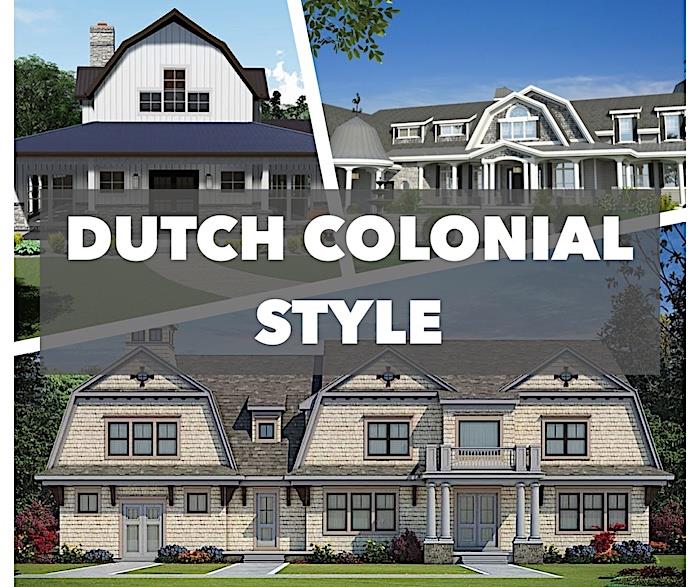Table Of Content

Notice the steep gabled roof, abruptly ending eaves, exterior shutters and the symmetrical rectangle design – all elements of British colonial architecture in the USA. The gambrel roof is the most distinctive aspect of a Dutch Colonial house. This roof type, resembling a barn roof, features two slopes on each side, providing additional living space in the upper level of the house. The top half of the gambrel roof extends along the length of the house, creating a broad and inviting appearance. Equally notable are the flared eaves that extend beyond the house walls.
See How a Plain Dutch Colonial Became a Cool, Modern Farmhouse
The most characteristic feature of an original Dutch colonial house is a gambrel roof. These roofs were so commonly used in Dutch-style houses that the popular name for them became “Dutch roofs” in the 18th century. The Dutch colonial houses are wide and the roofs have long eaves that extend to the sides of the buildings. Originally, the house was only one room, although this has changed over time. The materials include stone or brick for the house and wooden doors and shutters.
Popular Pages
The purpose of dutch doors was to allow fresh air in while keeping animals out. These homes were most prevalent in dutch colonies in New York, New Jersey, Delaware, and Connecticut. This means that these homes are often larger and have additional house wings, often sprouting from the sides or rear of the home. These newer homes tended not to revolve around the central hearth as much as their older counterparts because the new builders and residents had other sources of heat available.
L.A. Storyhood
'Looks Like a Museum': Historic Dutch Colonial Finds a Buyer in No Time - Realtor.com News
'Looks Like a Museum': Historic Dutch Colonial Finds a Buyer in No Time.
Posted: Thu, 05 May 2022 07:00:00 GMT [source]
During the late 1960s, a rebellion against modernism and a longing for more traditional styles influenced the design of modest tract housing in North America. Builders began to borrow freely from a variety of historic traditions, offering Neoeclectic houses that were "customized" using a mixture of features selected from construction catalogs. These homes are sometimes called Postmodern because they borrow from a variety of styles without consideration for continuity or context. However, Neoeclectic homes are not usually experimental and do not reflect the artistic vision you would find in a truly original, architect-designed postmodern home. Above is a very classic British colonial style house in Nantucket, MA (a really great place to visit BTW).
To this day, most Spanish homes in the Americas feature courtyards, especially in rural areas. While ceiling beams are necessary for any wooden house, the builders of Dutch homes left them exposed. As a TV host, author, spokesperson, builder and historic preservationist, he has been heavily involved in construction and remodeling for the better part of a half century. The Dutch Colonial style home has also inspired many more modern home layouts. To be a true Dutch Colonial, the siding needs to be wood clapboard, shingle, brick, or stone. It’s similar to what one sees along the canals in the Old Country – homes there were taxed based on their width, not height.
Long and narrow, shotgun houses are made to fit small city building lots. Only one room wide, these homes pack a lot of living into a narrow space. The Palliser Company, which published many plan books during the Victorian era, called stick architecture plain yet neat, modern, and comfortable. The angular and austere style couldn't compete with the fancy Queen Annes that took America by storm. Some Stick architecture did dress up in fancy Eastlake spindles and Queen Anne flourishes. Historians often credit writer Orson S. Fowler for the innovation of the unusual and rare Octagon style.

Collaborated with numerous clients all around the world in the field of architecture design, 3D modeling and software education. He's been teaching Rhinoceros3D to thousands of architects through How to Rhino community and various social media channels. The popularity of Dutch Colonial Revival architecture stretches far beyond its original regions. This style has left a lasting impact through its notable structures across the United States. This mix of local touches and classic Dutch features gives each home a feel all its own while still sharing that cozy charm people love about the Dutch Colonial Revival style. For example, in areas with a lot of stone, you might see houses made mostly of this sturdy material.
In Americas
This style also typically includes flared eaves, dormer windows, and a symmetrical façade. The interiors often feature a central hallway with rooms branching off, and many homes include a prominent chimney. Dutch Colonial houses, a beloved architectural style, are easily recognizable by their unique features. Originating from the Dutch settlers, these homes are a testament to a rich architectural history. Their practical design, often adapted to the local environment, showcases a blend of both aesthetic appeal and functionality.
Some houses have elements in common with Craftsman style; others feature such neoclassical details as Greek columns, Palladian windows, or Adamesque mantels. Unlike more academic revivals, the pleasantly informal Dutch Colonial reminds us of farmhouses and barns. Houses are clad in stucco, hand-split shingles, clapboard, and brick—as were the vernacular originals. This unique roof has two slopes on each side, with the lower slope steeper than the upper one.
However, Neo-Mediterranean houses are not careful recreations of any single historic style. If you remove the romantic decorative details, a Neo-Mediterranean home is more likely to resemble a no-nonsense, all-American Ranch or Raised Ranch. In 1957, architect Andrew Geller won international attention when The New York Times featured a distinctive A-frame house he built in Amagansett, Long Island, New York. Triangular and tee-pee shaped homes date back to the dawn of time, but several 20th-century architects awakened interest in the geometric A-frame form.
The houses have been lost in fires or disasters over the years and have been replaced by imposing residences to take advantage of the horizontal space in an ever-expanding city. Settlers built them south-facing so sunlight could enter and help heat the home. While most original Dutch homes were made of stone, the frame was wood. Wood frames gave the builders something to work with, no matter the type of exterior material they had access to. Dutch colonial homes have specific characteristics introduced to the United States by Dutch settlers.
The Monterey Style was born in 19th century California, but its popularity expanded throughout a growing 20th century United States. The simple yet regal design became popular with the less-than-rich but well-to-do class of Americans. The picturesque Tudor Cottage is usually asymmetrical with a steep, complex roofline. The floor plan tends to include small, irregularly-shaped rooms, and the upper rooms have sloping walls with dormers. The home may have a sloping slate or cedar roof that mimics the look of thatch. A massive chimney often dominates either the front or one side of the house.

No comments:
Post a Comment